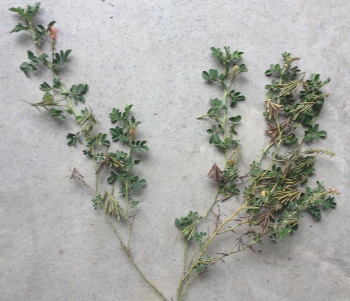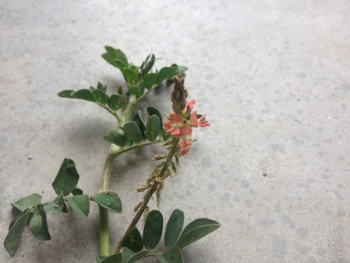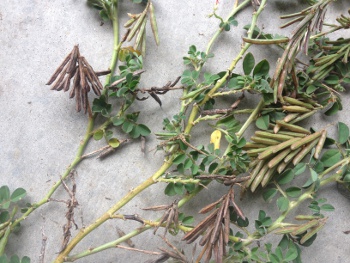- Return to Article Of The Month index
Creeping Indigo: A Small, Yet Lethal Plant
June, 2013
by Brent A. Sellers, UF/IFAS, Range Cattle REC, Ona; Bridget Carlisle, Polk County Extension; and Lindsey Wiggins, Multi-County Extension
Creeping indigo (Indigofera spicata) is a member of the legume family that is native to Africa. It was introduced from Ceylon into Gainesville, FL around 1925 to investigate several properties including nitrogen fixation as well as for forage. While this species is likely a good nitrogen fixer, toxicity was a concern as early as 1933 (Morton 1989).
Plant description. Creeping indigo is a prostrate plant (Figure 1), with a very shallow or submerged crown. Leaves contain seven to nine leaflets and are hairy. Stems are hairy, grow to 6 feet long, and root at the nodes. Flowers (Figure 2) arise from the base of the leaves, and contain numerous pink flowers. The plant reproduces by seed, which is the main cause of spread. Seed pods (Figure 3) are needle-like, stiff, approximately 1-inch long, and are borne in dense, downward-pointing clusters. The perennial root is a taproot, which is capable of growing at least 2-feet deep.
Toxicity. Most of the Indigofera species were initially utilized for dye production, however, creeping indigo does not contain as much dye as other species. Although creeping indigo was brought in as a potential forage, one of two rabbits did not survive an initial grazing trial (the second rabbit recovered after creeping indigo was removed from the diet). Recently, equine owners have become aware of this plant and have begun asking questions concerning its toxicity. Since hairy indigo (Indigofera hirsuta) is non-toxic to cattle, we commonly lumped creeping indigo into the same category. However, the toxicity questions and equine blogs continued to speculate, resulting in our increased interest in this species.
After a search in the literature, we were surprised to find several accounts of creeping indigo toxicity, as well as several cases of equine poisoning described by Morton (1989). Besides equine, cattle, sheep, rabbits, goats, guinea pigs, and fowl have also been poisoned by this plant. Apparently swine will not eat the plant, or have avoided it in all feeding tests. Cattle are susceptible to creeping indigo poisoning when the diet contains >50% creeping indigo. Symptoms of cattle poisoning include dullness, anorexia, muscular twitching, aimless walking, pressing head against objects, alternating diarrhea and constipation, abortion, and stillborn calves. Post-mortem findings typically include kidney and liver lesions, as well as lung and intestinal hemorrhaging, liver cirrhosis and hepatitis. Equine suffer from central nervous system disturbance, with seizures, corneal opacity, ulcerations and redness of gums, and miscarriages or abortions.
Toxic agent. The toxic agent in creeping indigo is indospicine and, to a lesser extent, canavanine. Indospicine is an analog to the amino acid arginine. Indospicine inhibits the incorporation of arginine and other amino acids in liver cells, resulting in liver insufficiency.
If poisoning by this plant is suspected, please contact your local veterinarian. If animals are showing symptoms of creeping indigo poisoning and the plant is in your pasture, it is important to remove the animals from those infested pastures immediately. Treatment of pastures with herbicides will likely be necessary for elimination of the plant. To date, we have no data on control of this plant. However, since aminopyralid is extremely active on legume species, the likelihood of GrazonNext HL providing good to excellent control of this weed is promising.
Reference:
Morton, J. F. 1989. Creeping indigo (Indigofera spicata Forsk.) (Fabaceae) – A hazard to herbivores in Florida. Econ. Bot. 43:314-327.




